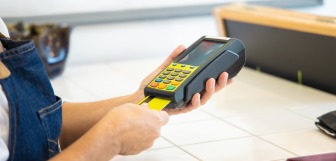Point of Sale Vs Point of Purchase
If you’re in the retail or design industries, you’ve probably heard the terms Point of Sale (POP) and Point of Purchase (POP). Without the proper context, it’s easy to be confused by these two very similar sounding terms.
Despite the fact that POS and POP both describe an interaction between the customer and a business, there are some vital differences that are worth exploring. Whether you’re a customer or a business owner, it’s useful to understand what these terms mean.
In this blog, we’ll explain what POS and POPs are and their fundamental differences.
What is POP?
A point of purchase, in simple terms, is a location in a shop or online store where a customer, prompted by the available products, considers making a purchase. Things such as eye catching displays, dump bins, shelf facings, and suggested products in an online shop can be POPs [1].
Point of purchase marketing is essential in increasing sales as customers that visit an in person or online store can often be convinced to increase their orders. Many shop owners organise their businesses in ways that get as many POPs in front of their customers as possible. Events, both online and in real life, that draw consumer attention, can also be considered POP marketing [2].
If you’ve ever visited a business with a specific item in mind and left with a full shopping bag, it’s safe to say that you’ve run into a successful POP marketing campaign. Building brand identity, capturing the customer’s attention and influencing their purchasing decisions towards impulse buys is the end goal of POP displays [3].
What is POS?
Defining a POS is slightly more complicated in that the term has two different meanings.
One definition of POS refers to the space in a shop where a transaction is made between the customer and the business. In real life, this space is the cash register. Online, it’s the checkout. Much in the same way as POPs, POSs can be strategically placed within shops to maximise sales by having customers pass specific departments or products [4].
Point of purchase displays are often placed alongside POS locations to encourage last-minute impulse purchases. In a retail context, this can be seen in supermarkets and convenience stores where gum and gift cards are displayed near or next to card readers [5].
POS can also refer to a number of different types of systems that businesses can use to accept payments and streamline their processes. It’s here that the differences between POPs and POSs become clear. These electronic point of sale systems (EPOS) are extremely adaptable and many, such as the Epos Now Complete Solution, are specifically designed to get business owners everything they need to run to make their lives easier.
What sets POPs and POSs apart?
With the definitions we’ve set out, it’s clear to see how despite the similar acronyms POPs and POSs are very different.
In marketing, both terms describe a way to present products to customers. It is when EPOS systems enter the frame that we can see the difference. While POPs are limited to marketing a project, the technology that comes along with POS systems is what truly sets them apart.
What can an EPOS system do?
As technology continues to improve at an exponential rate, businesses have an opportunity to take advantage of these new innovations. EPOS systems are becoming more and more prevalent across many industries and improving processes for thousands of entrepreneurs every year. But what can these systems do and how could they help your company?
EPOS systems use a mix of specialist software and hardware to maximise efficiency. For instance, the Epos Now complete solution includes:
- A receipt printer - these small printing devices use ink or thermal paper to create a customer record
- A tablet - a specialised tablet that replaces traditional cash registers and allows staff to quickly serve customers
- A barcode scanner - an electronic scanner that reads barcodes allowing you to identify product items on the EPOS system
- A PDQ machine - A card payment terminal used for chip and pin or contactless transactions
- A cash drawer- A lockable metal draw designed to securely store cash
These tools are specifically designed to allow you to run your entire business from one POS terminal. With an EPOS system, you can process payments, assign staff roles, and simplify your inventory management in a way that will improve your customers’ experience and make your own life easier.
An added bonus of an EPOS system is that it collects useful information such as customer buying habits. With every transaction, your system collects data that can improve your business and drive your sales. There are many different ways you can use your POS data including:
- Making customer lists - by compiling lists of your existing customers, you can begin to offer them benefits such as discounts and loyalty programs
- Track your employees’ productivity - by seeing how many customers your employees serve, you’ll know when to offer praise when they do well and offer training when they need it
- Monitor Sale trends - is one item or service performing especially well? You’ll be able to identify the trend and take advantage of it
- Analyse your inventory - by seeing what is selling and what isn’t, you have the insight to adjust what you order in and what to avoid
Many business owners choose to customise their systems to better serve the needs of their business. For instance, restaurants and bars could use a booking app that allows reservations and special requests to come straight to the system and improve their customer service.
Choosing the right POS system
As EPOS systems have evolved over the years, many companies have entered the space and released their own version. It’s important to do your own research and ensure you pick a system that meets your unique needs and has the reputation that lets you know you’re getting a service that won’t let you down.
Epos Now was founded in 2011 with the express purpose of making life easier for business owners and improving their customer service. Over 40,000 customers across three continents use the Epos Now complete system to drive their sales and maximise their profits.
Speak with one of our consultants today and unlock the potential of your business.




